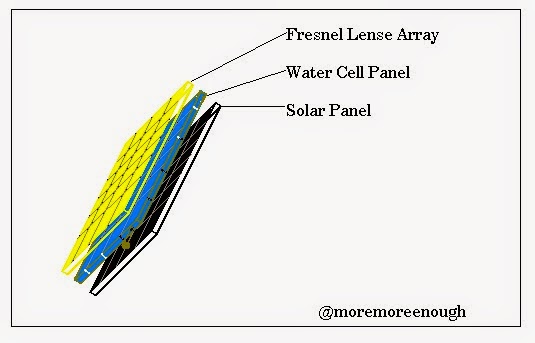For some time now, I've been thinking about an alternative energy configuration. I'm more of a creative type than an engineering sort... more of a dreamer than a doer. I have no idea how practical this design might be, or even if someone else has already made something similar. It's my hope that in the least, it might prompt someone with the resources and know-how to expand upon my idea - if it indeed shows any promise or novelty. Please forgive the crude diagrams I made using MS-Paint:
The idea here is that you'd construct a wafer comprised of a square matrix of water-tight glass cells, sandwiched between a tight array of Fresnel lenses and a solar panel. I imagine the thickness of the water cell layer to be no more than one inch. I'm thinking if such a configuration were to be 2' X 2' in surface area, each individual wafer panel would probably weigh over 100 lbs. Installing several on a rooftop shouldn't present significant weight strain considerations. No more so than would a couple of feet of wet snow accumulating on the roof... and if you live in a region where snow needs to be routinely shoveled away from your rooftop, such a system would obviously be unsuitable throughout most of the year anyway!
I apologize for the calamity of the schematic above. It's just intended to be a rough overview.
Water would be circulated through the glass cells underneath the Fresnel lens to become super heated. Maybe the hot water tank is situated right behind the east-facing roof where the solar wafer grid collects sun? In this way, the water temperature would be elevated to a nominal rate as the sun rises, merely by strategically locating it in the warmest part of the home.
Presuming the Fresnel lens concentrates enough sun rays to heat the water in the cells beneath to the boiling point, the resulting steam might then be condensed enough to supply the demands of a steam-powered electrical generator? In the least, this system should bring the temperature of the water high enough that it would take a minimal amount of conventional energy (natural gas, heating oil) to finish the job... whenever the sun is shining, that is. Of course, when the sun is shining down, you don't need as much heat anyway. That's where the idea of possibly (and probably noisily) converting the steam to electricity comes into play. If you already have a boiler supplied radiant heating system in your home, such a set-up might reduce your gas bill, but I doubt it would pay for itself in ten years time.
For what it's worth, there you have it. An idea for a very basic system to passively generate both electrical power and heat water from the same surface footprint.



No comments:
Post a Comment